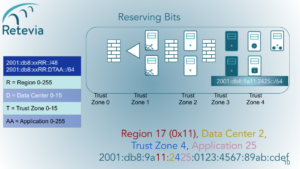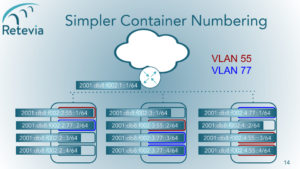I’ve said and written a lot about the economic drivers for IPv6. Not all networks are driven by economic drivers, though.
Friso Feenstra presented his bank’s decision tree on IPv6. They asked themselves questions like:
- Are we sure web sites in countries with little IPv4 space will have viable IPv4 access?
- More users will reach us over NAT444. Is that a problem? What do the security and forensics teams think?
- Will we miss features, applications, or web sites by not having IPv6? When will that happen? How much lead time will we have? Is it enough?
There are other drivers than economic. The answers to the questions above may provide some of them. Others include speed, segment routing, semantic numbering, container numbering, and operational extensions.
IPv6 is faster than IPv4, which can be good for search results and user engagement and purchasing, and just an overall better user experience.
Segment Routing over IPv6 is a network topology conceptually similar to MPLS, which adds interesting new capabilities to the network. Similar to MPLS, a packet entering the network gets a tag (label), but with SRv6, the entire path of labels can be specified. The labels can be the IPv6 addresses of intermediate nodes. In fact, the node may have an entire prefix, where an individual address is an instruction to the node on how to process it; this has been called “the network as a computer.” It’s potent, heady stuff, and with new variations and optimizations being developed in the IETF right now.
The abundance of addresses lets you design an address plan that is meaningful and makes operations easier. For instance, if each region in your network has just one /48, you could assign one digit to designate which data center (15 possible: 0 through f), one digit to specify a security “trust zone” (such as public, semi-trusted, confidential, management, audit, etc., with 15 possible: 0-f). You can then have two digits specifying the application or VLAN (255 possible: 0-ff). You still get a whole /64 per (V)LAN segment. Think about how easy your routing policy and security policy would be if you only had to examine one digit to apply a policy!

Matt Palmer, in his talk on IPv6 and Containers, does a great job showing how IPv6 can make container numbering and communication so much easier. (The IPv6 tutorial ends about 11 minutes in).

Performance and Diagnostics Metrics (PDM) (RFC8250) uses the Destination Options (DO) Extension Header (EH), something not available in IPv4, to expose round trip time and how much delay a server adds. It was designed for data center diagnostics; packets with EH are often dropped on the Internet, so use on a known network is more reliable.
Deploying IPv6 is not completely without obstacles, the largest of which is inertia. There are interesting reasons, though, for considering IPv6 as a core technology for a network, even without considering the economic drivers.